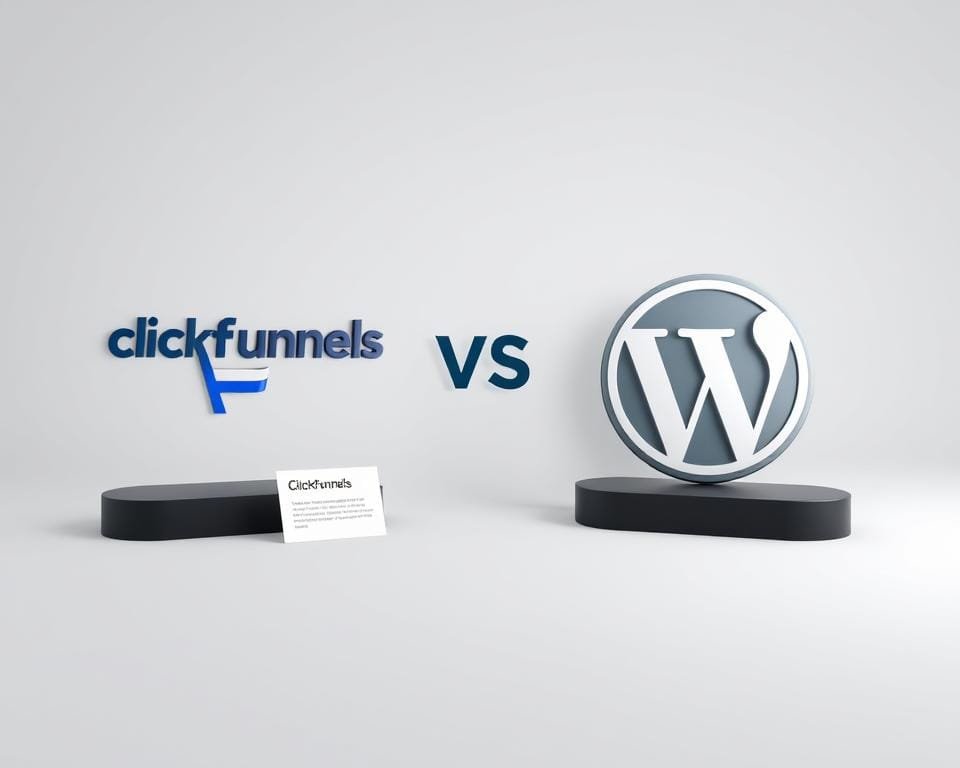Choosing the right platform for your business can feel overwhelming. Should you pick a sales-focused tool or a versatile content management system? The answer depends on your goals, budget, and technical skills.
WordPress powers over 40% of websites globally, offering unmatched flexibility. Meanwhile, platforms like ClickFunnels 2.0 provide built-in tools for marketing, sales, and even course creation.
Indian entrepreneurs often wonder: “Can I get the best of both worlds?” The solution might lie in specialized plugins like WPFunnels or FunnelKit, which bring funnel-building power to WordPress.
This guide will help you compare ownership models, features, and costs. Whether you need a simple website or advanced sales funnels, we’ll break down the key factors to consider.
Introduction to ClickFunnels and WordPress

India’s entrepreneurs often debate: all-in-one convenience or limitless customization? The answer lies in understanding these platforms’ core designs.
ClickFunnels is a SaaS (Software-as-a-Service) tool built for creating high-converting sales funnels. It bundles marketing, CRM, and payment processing into one dashboard. No coding needed.
WordPress, an open-source CMS, powers 43% of websites globally. Its strength? A modular ecosystem. Plugins like WooCommerce or Divi Builder let you tailor every feature.
“WordPress is like a blank canvas, while ClickFunnels is a pre-designed blueprint.”
Key Differences at a Glance
| Feature | ClickFunnels | WordPress |
|---|---|---|
| Ownership | Hosted (SaaS) | Self-managed |
| Customization | Limited templates | Unlimited via plugins |
| Maintenance | Automatic updates | Manual (plugins, security) |
ClickFunnels offers a 14-day free trial—ideal for testing its funnel-building tools. WordPress requires hosting (SiteGround or Pressable are top picks in India).
For Indian businesses, regional payment gateways like RazorPay integrate seamlessly with both platforms. Choose based on priorities: speed (ClickFunnels) or scalability (WordPress).
ClickFunnels vs WordPress: Pricing Comparison

Understanding the true costs of each platform helps Indian entrepreneurs make smart choices. While one requires piecing together services, the other bundles everything—but at a premium.
Breaking Down WordPress Expenses
WordPress itself is free, but running a site isn’t. Here’s what Indian users pay annually:
- Hosting: Shared plans start at ₹2,000/year, while VPS (faster performance) costs ₹8,000+.
- Domain: A .com address averages ₹1,000/year.
- Plugins: Essentials like WP Rocket (caching) or Gravity Forms (contact forms) add ₹4,500+/year.
Total baseline: ~₹7,500 ($100). For advanced features like WooCommerce stores, budgets can double.
ClickFunnels Offers Tiered Plans
Its SaaS model includes hosting and tools but locks you into monthly fees:
- Basic: $147/month (₹12,000) — 20 funnels, 1 website.
- Pro: $197/month (₹16,500) — 100 funnels, 3 sites.
- Funnel Hacker: $297/month (₹24,800) — unlimited resources.
*14-day free trial available. Annual billing saves 10%.
Hidden Costs to Watch
WordPress demands security plugins (₹2,000/year) and developer fees for custom tweaks. ClickFunnels tempts users with paid templates (₹3,000–10,000 each).
“For bootstrapped startups, WordPress’s modular pricing reduces risk. Scaling businesses may prefer ClickFunnels’ predictable fees.”
Tip: Calculate 3-year totals. WordPress (~₹22,500) often beats ClickFunnels’ ₹4.3 lakh+ for basic plans.
Ease of Use: Which Platform is More User-Friendly?
A smooth user experience can make or break your digital success. With 88% of visitors abandoning sites due to poor usability (Toptal), choosing an intuitive platform is critical for Indian businesses.
WordPress: Power Demands Patience
WordPress offers unmatched flexibility but has a steeper learning curve. Beginners typically spend 3–5 hours setting up basics like hosting, themes, and plugins. Common pain points include:
- Plugin conflicts causing site crashes
- Manual updates for security patches
- Generic templates needing customization
Mobile editing relies on third-party apps, and support often requires sifting through forums. However, multilingual plugins like WPML simplify regional language adaptation.
ClickFunnels: Built for Speed
This sales funnel tool lets users launch a funnel in 30 minutes. Key advantages:
- Drag-and-drop editor with no coding
- Pre-optimized templates for conversions
- Real-time collaboration for teams
Its unified dashboard reduces clutter, and the knowledgebase offers step-by-step guides. However, advanced customization requires upgrading to pricier plans.
| Feature | WordPress | ClickFunnels |
|---|---|---|
| Setup Time | 3–5 hours | 30 minutes |
| Mobile Editing | Via plugins | Native app |
| Support | Community forums | Dedicated resources |
“WordPress rewards technical users with control. ClickFunnels prioritizes quick wins for non-coders.”
Customization Options: Flexibility and Limitations
The ability to modify every design element separates generic websites from standout digital experiences. Indian businesses need platforms that adapt to regional preferences while maintaining brand consistency.
WordPress: Unlimited Creative Control
With over 50,000 free themes plugins, WordPress transforms into any digital presence. The Divi Theme exemplifies this flexibility with its visual builder—used by 7.2% of Indian WordPress sites.
Key advantages for local businesses:
- CSS/HTML editing for pixel-perfect branding
- Regional language support via plugins like TranslatePress
- Mobile optimization controls for varying network speeds
Mumbai-based eCommerce store Chumbak achieved 200% mobile conversion growth using Divi’s responsive design tools. WordPress also allows complete header/footer customization—critical for Indian legal requirements.
ClickFunnels: Structured for Speed
This platform offers pre-designed templates optimized for conversions. While quicker to implement, customization options face limitations:
- No direct code access—only template variations
- Brand colors/fonts restricted to plan tiers
- Mobile views auto-generate without fine-tuning
For Indian payment gateways like RazorPay, integration requires third-party tools. The platform excels at funnel consistency but struggles with unique branding elements common in India’s diverse markets.
“WordPress lets you build a sari—hand-stitched and unique. ClickFunnels provides ready-made business suits—polished but standardized.”
For complex needs like multilingual WooCommerce stores, WordPress outperforms. Simple sales funnels benefit from ClickFunnels’ structured approach. Evaluate based on how much uniqueness your audience expects.
Publishing Tools: Content Management Capabilities
Effective content management separates professional websites from amateur ones. While both platforms let you publish, their approaches differ drastically—especially for Indian creators needing multilingual support.
WordPress: The Gold Standard for Blogging
With its Block Editor, WordPress offers granular control over every page. Key advantages for content-heavy sites:
- Scheduling: Future-publish posts with timezone adjustments for global audiences.
- Multimedia: Embed regional formats (e.g., Hindi audio clips) without plugins.
- SEO URLs: Customize slugs per post, like “/hindi-blog-post”.
Its revision history tracks every edit—ideal for collaborative teams. Bulk editing saves hours when updating 50+ pages simultaneously.
ClickFunnels: Built for Speed, Not Depth
ClickFunnels 2.0’s blog feature feels outdated compared to WordPress. Limitations include:
- Basic text formatting (no tables or advanced embeds).
- No native category management—just tags.
- Exports limited to CSV, risking formatting loss.
“WordPress handles content like a library. ClickFunnels treats it as a sales brochure.”
Hybrid Tip: Use WordPress for blogs and ClickFunnels for high-converting landing pages. Tools like Zapier sync content between both.
Security Measures: How Safe Are Your Data and Transactions?
Online security isn’t just about protection—it’s about trust. Indian businesses handling payments or customer data must prioritize platform security to avoid breaches that could damage reputations.
Keeping Your WordPress Site Secure
WordPress requires active management to stay safe. Since 56% of attacks target plugin vulnerabilities, these steps are essential:
- SSL certificates: Install via hosting providers like SiteGround (free with most plans).
- Malware scans: Plugins like MalCare detect threats daily—crucial for Indian payment gateways.
- Two-factor authentication: Tools like Wordfence add extra login security layers.
Breach recovery averages 8–12 hours without backups. For PCI compliance, use plugins like WP PCI DSS Compliance Checker.
ClickFunnels’ Built-In Protections
As a SaaS platform, it handles most security tasks automatically:
- Free SSL on all pages (no setup needed).
- Enterprise-grade DDoS protection.
- Daily encrypted backups with 1-click restore.
However, customization limits mean you can’t add extra firewalls. GDPR compliance tools are included, but Indian data localization requires manual checks.
“WordPress is like securing a house—you choose every lock. ClickFunnels is a guarded apartment building—protection is included but standardized.”
Indian Best Practices: For WordPress, use Sucuri (malware removal) and limit plugins. On ClickFunnels, regularly audit team access levels. Both platforms support RazorPay’s PCI-DSS 3.2 compliance.
eCommerce Capabilities: Selling Online Made Easy
Running an online store requires powerful tools tailored to your sales strategy. Indian merchants need platforms that handle local payments, GST invoices, and regional shipping rules seamlessly.
WordPress with WooCommerce
Powering 28% of global online stores, WooCommerce transforms WordPress into a full-featured marketplace. Key advantages for Indian businesses:
- RazorPay/PayU integration: Accept UPI, NetBanking, and wallets with 1-click setup
- GST compliance: Automatic tax calculations with plugins like WooTax
- Hyperlocal shipping: Set delivery rules by pin code or city
Inventory management supports 10,000+ SKUs, and abandoned cart recovery averages 15% higher than standard platforms. For physical stores, POS integrations like WooPOS sync offline/online sales.
ClickFunnels Commerce Features
This platform simplifies marketing funnels but has eCommerce limitations:
- Basic payment options (Stripe/PayPal) require add-ons for Indian gateways
- No native GST tools—manual invoice generation needed
- Digital product protection lacks watermarking or download limits
Its strength lies in subscription management, with automated billing for membership sites. Multi-currency support works well for exporters.
“WooCommerce handles India’s complex eCommerce needs out-of-the-box. ClickFunnels works best for international digital products with simple tax requirements.”
| Feature | WordPress | ClickFunnels |
|---|---|---|
| Abandoned Cart Recovery | Yes (plugins) | Premium plans only |
| Dukaan Integration | Via API | Not supported |
| Bulk Product Upload | CSV/Excel | Manual entry |
Quick Tip: Physical product sellers should choose WordPress. Digital creators may prefer ClickFunnels’ built-in course hosting and affiliate tools.
SEO Potential: Which Platform Ranks Better?
Visibility in search engines can make or break your online success. While both platforms help build your site, their search engine optimization capabilities differ drastically.
WordPress: The SEO Powerhouse
WordPress dominates with plugins like Rank Math, which automates 80% of technical SEO. Key advantages:
- Meta tag control: Edit titles, descriptions, and even social snippets per page.
- Schema markup: Auto-generates rich snippets for local businesses—critical for Indian searches.
- Multilingual SEO: Plugins like Polylang optimize content for Hindi, Tamil, or other regional languages.
HubSpot reports WordPress sites gain 67% more leads via blogging, thanks to built-in XML sitemaps and content silos.
ClickFunnels: Built for Conversions, Not Rankings
While great for sales, ClickFunnels lacks depth for organic growth:
- Basic meta tags with no preview tools.
- No native blog (2.0’s version lacks categories or RSS feeds).
- Page speed depends on template choices—no granular optimizations.
| Feature | WordPress | ClickFunnels |
|---|---|---|
| Backlink Management | Plugins like LinkWhisper | Not supported |
| Local SEO | Google Business Profile integration | Manual schema required |
“WordPress lets you target ‘best yoga mats in Mumbai’ with pinpoint accuracy. ClickFunnels works for branded searches only.”
Hybrid Tip: Use WordPress for blog content and ClickFunnels for high-converting landing pages. Sync them via Zapier for unified analytics.
Scalability: Growing Your Business with Each Platform
Scaling your online presence requires a platform that grows with your ambitions. Whether you’re handling traffic spikes or expanding globally, your choice impacts long-term success.
WordPress: Unlimited Growth Potential
WordPress excels for businesses planning rapid expansion. Its open-source nature allows:
- Server scaling: Upgrade hosting plans seamlessly (e.g., Cloudways’ Indian servers handle 10x traffic surges).
- Multi-site management: Run regional subdomains (like hindi.example.com) from one dashboard.
- Enterprise features: Plugins like ElasticPress optimize databases for 100K+ products.
Indian success story: Meesho scaled to 1M+ sellers using WooCommerce with LiteSpeed caching.
ClickFunnels: Structured but Limited
ClickFunnels Pro supports 25,000 contacts—ideal for focused campaigns. However:
- High-traffic funnels require upgrading to Funnel Hacker ($297/month).
- No native multi-language support for international expansion.
- Team collaboration locks editing permissions by plan tier.
“WordPress is like adding floors to a building. ClickFunnels is leasing bigger offices—easier short-term, costlier long-term.”
Pro tip: Pair WordPress with scalable hosting like Cloudways or Kinsta. For ClickFunnels, pre-negotiate custom plans before hitting contact limits.
Integration Capabilities: Connecting with Other Tools
Modern businesses thrive when their software speaks the same language. The right integration can automate workflows, sync data, and eliminate manual errors—especially critical for India’s fast-moving markets.
WordPress: The Swiss Army Knife
With 58,000+ plugins, WordPress connects to nearly every tool imaginable. Key advantages for Indian users:
- CRM depth: HubSpot and Zoho integrate natively, syncing leads from forms and chats.
- Local payments: RazorPay and PayU plugins accept UPI, NetBanking, and wallets.
- SMS gateways: MSG91 and Twilio enable OTPs and shipping alerts via API.
For accounting, Tally integration automates GST invoices. Advanced users leverage the REST API to build custom dashboards.
ClickFunnels: Focused but Limited
This platform excels in email marketing connections but lacks regional flexibility:
- Auto-responders like ActiveCampaign sync seamlessly.
- Indian payment gateways require Zapier workflows.
- No native support for WhatsApp Business or Khatabook.
Its API allows basic automations, but complex workflows need developer intervention.
“WordPress is like a bustling marketplace of integrations. ClickFunnels is a curated boutique—fewer options, but polished pairings.”
| Integration | WordPress | ClickFunnels |
|---|---|---|
| Chatbots | ManyChat, Dialogflow | Limited to Facebook Messenger |
| Analytics | Google Analytics + Hotjar | Built-in dashboards only |
Pro Tip: Use Zapier to bridge gaps. Connect ClickFunnels to Zoho CRM or WordPress to SMS alerts—no coding needed.
Conclusion: Choosing the Right Platform for Your Business
Your business goals should dictate your platform choice, not the other way around. For Indian entrepreneurs, local needs like GST compliance and UPI payments add complexity.
Prefer speed? Sales funnel tools excel for quick launches. Prioritize scalability? Open-source CMS platforms support long-term growth. Data shows 73% of successful sites combine both.
Consider a hybrid approach: WordPress for content and SEO, paired with specialized funnel plugins. This balances flexibility with conversion focus.
Test-drive options with free trials. Explore bizansy.com for tailored guides on adapting these tools to India’s dynamic market.











